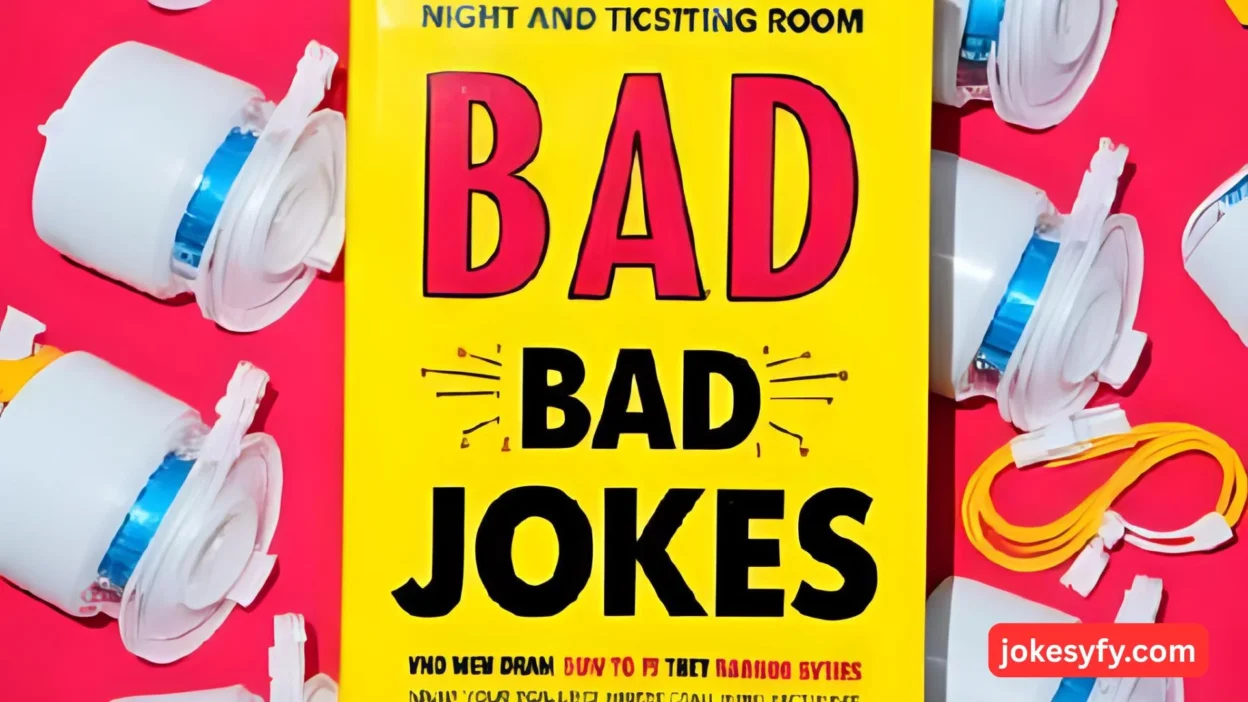Bad jokes—those eye-roll-worthy puns and groaners—are more than just failed attempts at comedy 😅. They bring laughter, connection, and sometimes life lessons hidden behind their awkward charm. In this article, we’ll dive into the world of bad jokes, exploring what makes them funny, why they matter, how to tell them, and even how they can help us bond or heal ❤️. By the end, you’ll not only laugh at silly one-liners but also appreciate the deeper role Corny humor plays in our everyday lives.
What Counts as a Bad Joke
- Predictable punchlines that make you laugh only because you saw them coming 😂.
- Dad jokes that are wholesome but painfully obvious.
- Puns stretched so far they almost break language rules 😅.
- Anti-jokes where the “punchline” is just literal truth.
- Corny one-liners you’ve heard a million times.
- Jokes that rely on clichés without adding freshness.
- Failed timing—punchline delivered too soon or too late.
- Simple wordplay that earns more groans than laughs.
- Childish humor that still sneaks a smile 🌱.
- Silly exaggerations that miss the mark.
- Knock-knock jokes that feel outdated but still get told.
- Visual gags that flop because setup isn’t clear.
- Observations so trivial they confuse instead of amuse.
- Delivery so flat it makes the joke worse.
Why We Laugh at Bad Jokes (The Psychology of Cringe Humor)
- They surprise us with twisted expectations 💡.
- Awkwardness itself becomes funny.
- Shared groans unite groups—“that was awful but hilarious.”
- Nostalgia reminds us of childhood humor ❤️.
- Simple puns engage our brains just enough.
- The failure is sometimes funnier than success.
- They relieve tension in awkward conversations.
- Imperfect humor makes people feel more human 🌱.
- Bad jokes show humor doesn’t need perfection.
- Laughing at cringe builds resilience.
- They work as emotional reset buttons.
- Sometimes delivery is funnier than punchline 😅.
- They remind us laughter is subjective.
- Groan-worthy humor often sparks “laugh after the laugh.”
- Their simplicity makes them inclusive for everyone.
Types and Categories of Bad Jokes
- Puns: “I used to be a banker but I lost interest.” 🤓
- Dad jokes: wholesome, safe, but painfully obvious.
- Anti-jokes: “Why did the chicken cross the road? To get to the other side.”
- Knock-knock jokes: classic but often stale.
- Groaners: so corny they force a sigh.
- Corny one-liners: “I’m on a seafood diet. I see food and eat it.”
- Non sequitur jokes: punchline has no logic.
- Meme humor: text jokes that feel outdated.
- Exaggeration jokes: too over-the-top to work.
- Literal jokes: where figurative meaning is killed.
- Corny riddles: predictable Q&A style.
- Culture-lost jokes: funny in one language, flat in another 🌍.
- Self-deprecating humor: weak but relatable.
- Failed sarcasm: where tone ruins the effect.
How to Tell Bad Jokes Well
- Keep setup short and snappy 😊.
- Pause just before punchline for suspense.
- Deadpan tone often boosts fun.
- Go exaggerated for sillier delivery.
- Use eye contact or goofy expressions.
- Add self-awareness: “This is going to be terrible…” 😅.
- Don’t rush—bad jokes need awkward pacing.
- Confidence sells even the worst punchline.
- Read your audience—some love groaners more than others.
- Repeat occasionally—callback humor works.
- Avoid overuse, or you’ll drain the charm.
- Timing matters more than wording.
- Sometimes silence after punchline is funniest.
- Laugh at your own joke—it makes others laugh too.
- Remember, it’s about fun, not perfection ❤️.
Classic Examples of Bad Jokes & Why They Work
- “Why don’t scientists trust atoms? Because they make up everything.” 🤓
- “What do you call fake spaghetti? An impasta.”
- “I told my wife she drew her eyebrows too high. She looked surprised.”
- “Why did the scarecrow win an award? He was outstanding in his field.” 🌾
- “I would avoid sushi—it’s a little fishy.”
- “I’m reading a book on anti-gravity. Impossible to put down.”
- “What do you call a belt made of watches? A waist of time.” ⏰
- “Why did the bicycle fall over? It was two-tired.”
- “Parallel lines have so much in common. Too bad they never meet.”
- “Restaurant on the moon? Great food, no atmosphere.” 🌙
- “I see food and I eat it—seafood diet.”
- “I used to play piano by ear, but now I use my hands.” 🎹
- “What do May flowers bring? Pilgrims.”
- “Time travel joke… but you didn’t like it.”
- “Told my friend 10 jokes. No pun in ten did.” 😅
When Bad Jokes Backfire
- They insult or stereotype.
- Wrong timing (serious setting).
- Too many at once bore the crowd.
- Over-explaining kills humor.
- If no one gets the pun, it falls flat.
- Jokes in wrong culture may offend 🌍.
- Some settings need professional tone.
- Weak sarcasm gets misunderstood.
- Inside jokes exclude listeners.
- Overly childish jokes annoy adults.
- A joke that confuses instead of amuses.
- Punchline too delayed, audience loses patience.
- Negative energy ruins delivery.
- Embarrassment overtakes laughter 😬.
Using Bad Jokes to Bond & Heal
- They break the ice in awkward moments.
- Shared groans bring people closer ❤️.
- Laughter eases tension during stress.
- They prove it’s okay to be imperfect.
- They lighten heavy moods instantly.
- Bad jokes are universal—anyone can tell one.
- They help introverts join conversations.
- Used as icebreakers in meetings 💼.
- They can distract from sadness for a moment.
- A silly pun often makes a child’s day.
- Couples share bad jokes as inside humor.
- Family gatherings love Corny riddles.
- Hospitals sometimes encourage jokes for healing.
- Teachers use them to keep classrooms lively 📚.
- They create memories that stick.
How to Create Your Own Bad Jokes
- Start with everyday words and twist them 😅.
- Think of double meanings.
- Keep wording simple.
- Avoid long setups.
- Watch reactions—groans mean success.
- Adjust timing if flat.
- Add delivery cues (pause, tone).
- Use callbacks to earlier jokes.
- Stay lighthearted, not offensive.
- Write ideas down during day.
- Turn clichés into punchlines.
- Mix random topics for absurdity.
- Use self-deprecating humor for relatability.
- Embrace failure—it’s part of the fun ❤️.
Life Lessons Hidden in Corny Humor
- Imperfection is okay 🌱.
- Laughter heals even if it’s silly.
- Groans still count as joy.
- Humor is subjective—so is life.
- Connection matters more than punchline.
- Humility: we’re all awkward sometimes.
- Courage: telling a bad joke takes guts 💪.
- Resilience: joke fails? Try again.
- Gratitude: joy in little moments.
- Empathy: reading people’s reactions.
- Simplicity: the smallest joke can brighten a day.
- Creativity: wordplay strengthens thinking.
- Balance: life is both serious & silly.
- Humanity: shared cringe = shared love ❤️.
Tips for Sharing Bad Jokes
- Sprinkle them into conversations casually.
- Start with an obvious pun 😅.
- Watch audience mood before dropping one.
- Use emojis/text jokes online.
- Keep delivery confident.
- Use pauses for maximum cringe.
- Avoid repeating same pun too often.
- Acknowledge joke’s silliness—it helps.
- End with a smile no matter reaction.
- Use as icebreakers in groups.
- Invite others to share their bad jokes.
- Turn it into a game at gatherings 🎉.
- Add gestures to boost effect.
- Laugh at yourself too—it’s disarming.
- Keep humor light, never mean-spirited.
Conclusion
At the end of the day, bad jokes remind us that laughter doesn’t have to be polished to be powerful. They bring people together, ease stress, and teach us humility in the most lighthearted way. So go ahead—drop that corny pun, embrace the groan, and laugh through life’s imperfections 😅.

I am Charles K Baxter, a humor enthusiast passionate about spreading joy and positivity through laughter.




